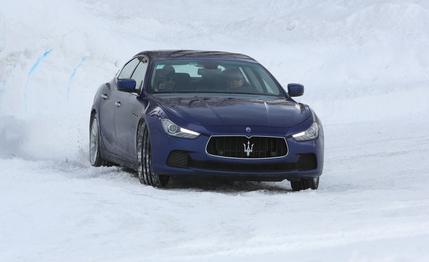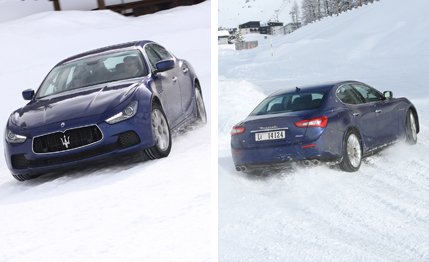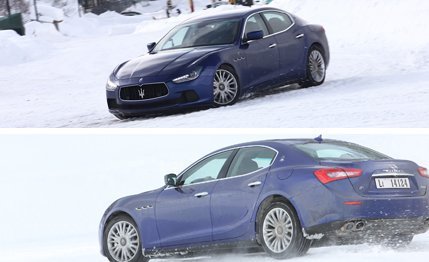 First Drive Review
First Drive Review
Disneyland’s Matterhorn roller-coaster ride is a must-do for every child, spoiled or otherwise. Experiencing the real thing in car form in the European Alps should, therefore, be high on every grown-up’s bucket list. Thanks to Maserati, you can check that item off your register, at least vicariously, by climbing aboard a Ghibli sports sedan equipped with the optional Q4 all-wheel-drive powertrain.
Maserati is currently enjoying a party frame of mind. One hundred years have passed since the five founding brothers began fiddling with race cars in Bologna, Italy (although they didn’t begin producing automobiles for sale until 1926). Thanks to a new Quattroporte flagship and Ghibli mid-size sedan in the lineup, U.S. sales are surging. Stepping out of the shadows with elegantly designed, intelligently engineered alternatives to the German juggernauts has been a shrewd move for this brand, and Maserati is finally demonstrating its worth as the semiprecious jewel in the Fiat-Chrysler crown.

Maserati introduced its magnificent Ghibli DOHC V-8–powered sports coupe in 1966 and sold 1150 of them during the following seven years. The new designed-in-house revival is for all intents a junior Quattroporte four-door sedan. The general front-engine, rear-drive layout, key parts of the unitized body and chassis, and the front doors are shared between the two Maser sedans. A 523-hp, twin-turbo 3.8-liter V-8 is exclusive to the Q’porte. A 3.0-liter twin-turbo V-6 producing 345 horsepower is the base engine for both sedans. Q4 (Italian for “four-by-four”) editions receive a 404-horse version to compensate for a slightly higher curb weight. Aluminum block-and-head construction and direct fuel injection grace all three engines.
Q4-titude
Maserati engineers beam with pride over the Q4 driveline, which adds $10,100 to the Ghibli’s price but a mere 132 pounds to its claimed curb weight. The beauty of the system is its ability to extend mobility into winter’s bad-weather months without significantly disturbing core driving dynamics. Added components are simple and elegant. Without altering the low-slung, front-midship engine location, a power-transfer unit is bolted to the tail of the Ghibli’s ZF eight-speed automatic transmission. A wet multiplate clutch electronically controlled via a servo actuator supplies a portion of the output torque to a train of three gears that spin a shaft running forward along the right side of the transmission. This shaft powers the front differential bolted to the engine’s cast-aluminum oil sump. One half-shaft passes through the sump to drive the left-front wheel; the other runs in the open to spin the right-front wheel. Cars are delivered with the customer’s choice of summer or winter tires, and Maserati North America is thinking about adding a third choice—all-season rubber.

Q4 is an on-demand system that rises to the propulsion cause only when instructed to do so. A savvy controller monitors parameters such as car speed, throttle position, steering angle, and yaw motion with an electronic eye peeled for any hint of rear tire slippage. When there is slippage, even with the engine still at idle, up to half of the available torque is dispatched to the front tires in 0.15 or less second. Operating boundaries are no more than 885 lb-ft of torque to the front wheels when there is no grip available at the rear axle and no front drive at all above 81 mph. The front differential is an open design; a clutch pack in the rear differential provides 35-percent locking during acceleration and 45-percent during braking.
Maserati’s engineering team chose this approach to winter mobility because the driveline clutch operates smoothly and silently, never imposing its will over the V-6 engine’s spirit and vitality. Likewise, there’s no hint through the hydraulically assisted rack-and-pinion power steering when the front-tire steering-and-driving duties are in flux.